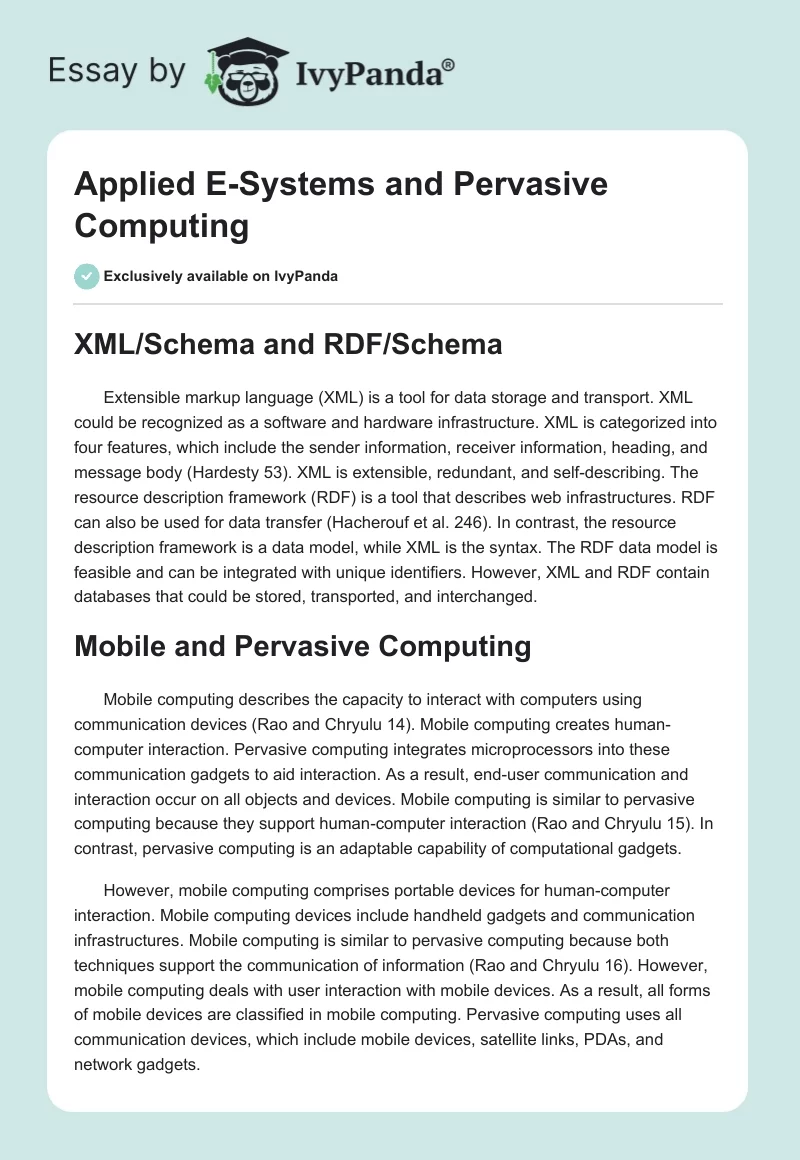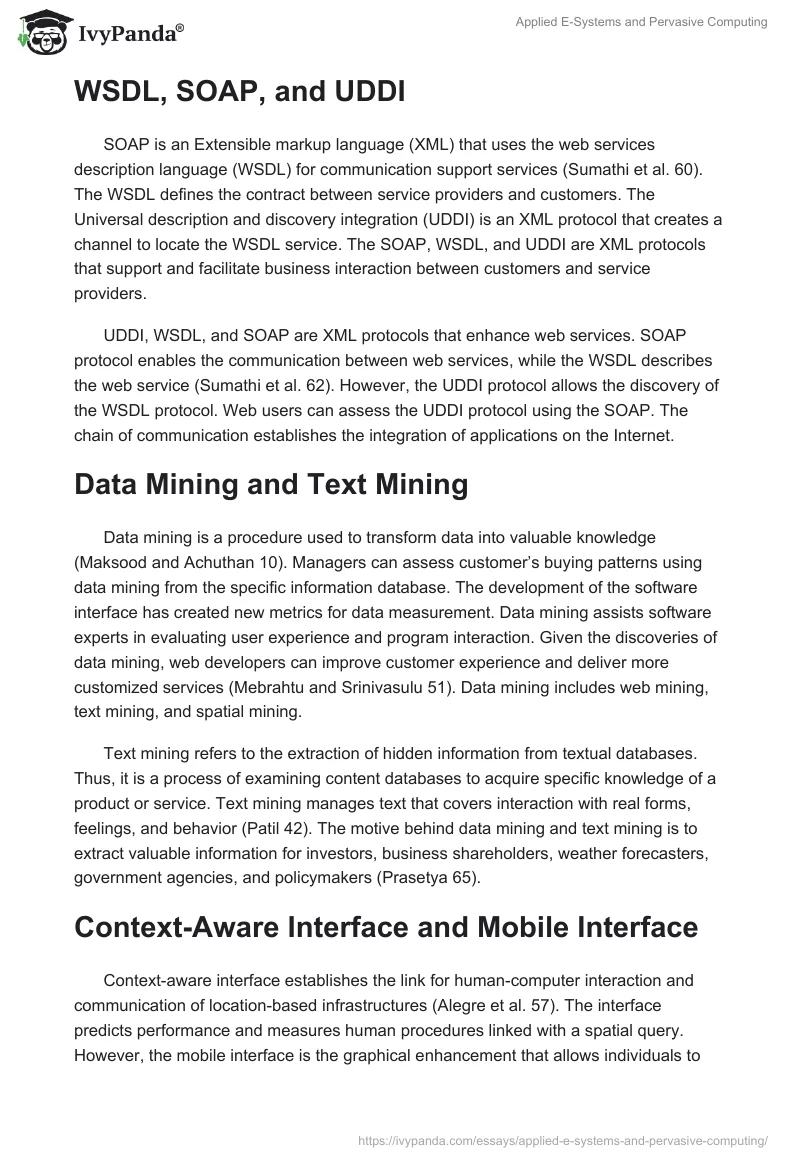XML/Schema and RDF/Schema
Extensible markup language (XML) is a tool for data storage and transport. XML could be recognized as a software and hardware infrastructure. XML is categorized into four features, which include the sender information, receiver information, heading, and message body (Hardesty 53). XML is extensible, redundant, and self-describing. The resource description framework (RDF) is a tool that describes web infrastructures. RDF can also be used for data transfer (Hacherouf et al. 246). In contrast, the resource description framework is a data model, while XML is the syntax. The RDF data model is feasible and can be integrated with unique identifiers. However, XML and RDF contain databases that could be stored, transported, and interchanged.
Mobile and Pervasive Computing
Mobile computing describes the capacity to interact with computers using communication devices (Rao and Chryulu 14). Mobile computing creates human-computer interaction. Pervasive computing integrates microprocessors into these communication gadgets to aid interaction. As a result, end-user communication and interaction occur on all objects and devices. Mobile computing is similar to pervasive computing because they support human-computer interaction (Rao and Chryulu 15). In contrast, pervasive computing is an adaptable capability of computational gadgets.
However, mobile computing comprises portable devices for human-computer interaction. Mobile computing devices include handheld gadgets and communication infrastructures. Mobile computing is similar to pervasive computing because both techniques support the communication of information (Rao and Chryulu 16). However, mobile computing deals with user interaction with mobile devices. As a result, all forms of mobile devices are classified in mobile computing. Pervasive computing uses all communication devices, which include mobile devices, satellite links, PDAs, and network gadgets.
WSDL, SOAP, and UDDI
SOAP is an Extensible markup language (XML) that uses the web services description language (WSDL) for communication support services (Sumathi et al. 60). The WSDL defines the contract between service providers and customers. The Universal description and discovery integration (UDDI) is an XML protocol that creates a channel to locate the WSDL service. The SOAP, WSDL, and UDDI are XML protocols that support and facilitate business interaction between customers and service providers.
UDDI, WSDL, and SOAP are XML protocols that enhance web services. SOAP protocol enables the communication between web services, while the WSDL describes the web service (Sumathi et al. 62). However, the UDDI protocol allows the discovery of the WSDL protocol. Web users can assess the UDDI protocol using the SOAP. The chain of communication establishes the integration of applications on the Internet.
Data Mining and Text Mining
Data mining is a procedure used to transform data into valuable knowledge (Maksood and Achuthan 10). Managers can assess customer’s buying patterns using data mining from the specific information database. The development of the software interface has created new metrics for data measurement. Data mining assists software experts in evaluating user experience and program interaction. Given the discoveries of data mining, web developers can improve customer experience and deliver more customized services (Mebrahtu and Srinivasulu 51). Data mining includes web mining, text mining, and spatial mining.
Text mining refers to the extraction of hidden information from textual databases. Thus, it is a process of examining content databases to acquire specific knowledge of a product or service. Text mining manages text that covers interaction with real forms, feelings, and behavior (Patil 42). The motive behind data mining and text mining is to extract valuable information for investors, business shareholders, weather forecasters, government agencies, and policymakers (Prasetya 65).
Context-Aware Interface and Mobile Interface
Context-aware interface establishes the link for human-computer interaction and communication of location-based infrastructures (Alegre et al. 57). The interface predicts performance and measures human procedures linked with a spatial query. However, the mobile interface is the graphical enhancement that allows individuals to interact with their device and communication infrastructure. In contrast, the mobile interface is a program that links the software and hardware. However, a content-aware interface connects the established link to specific locations.
The Impact of Adaptation
Adaptation improves the proficiency of application use by programming, application development, and user experience (Krupitzer et al. 189). Application adaptations could be leveled, supervised, or realized adaptation. Software adaptions improve business communication and information transfer. However, the challenges of adaptation include context modeling, reasoning, and identification. As a result, adaptability creates issues in communication development and performance.
For example, it is difficult to gather contextual data in a distributed environment. Consequently, it is challenging to integrate software in a mobile environment. However, the adaptation architecture for pervasive computing provides solutions to mitigate these challenges. Thus, adaptation plays a vital role in context administration, middleware, plan administration, and decisional capacities (Krupitzer et al. 186).
In pervasive computing, adaptation architecture operates on the application and system levels. The application architecture supports programs and software (Krupitzer et al. 188). As a result, communication challenges would affect the adaptation process. However, the system adaptation level provides services for the device and software. As a result, interruptions and interaction failures would not affect the communication link.
The context-setting defines the operating system and user interface. The operating system includes software, programs, or network assets. Consequently, the user interface comprises the structure, software interface, and visualization properties. Thus, application adaptation can affect ubiquitous computing in three different ways. One, reactive adaptation allows applications to change their status, functions, and settings. This ability to adapt applications enhances device efficiency and performance. Evaluative adaptation extends the capacity of application software to mitigate errors and improve performance by changing user preferences and functionality (Krupitzer et al. 201).
The Effect of Pervasive/Ubiquitous Computing for E-commerce
Ubiquitous computing mitigates the challenges of e-commerce to allow users to get an exciting experience. Pervasive computing builds on ambient intelligence and transfers information using smart devices. The design and capacity of smart devices make them adaptable in business settings. As a result, shareholders and investors create programs that integrate network infrastructures and business organizations.
Due to market instability, smart devices are designed to be flexible and compatible. These adaptable features create limitations for the software application. However, the benefits of smart devices in e-commerce outweigh its disadvantages. Thus, pervasive computing builds on existing protocols to establish an efficient communication channel for investors and customers.
For example, the use RFID label to lower the cost of surgery equipment describes the benefit of pervasive computing (Dhawan et al. 121). This process improves the supply logistics and minimizes waste. As a result, large corporations like Wal-Mart and Tesco deploy pervasive computing in their operations to enhance user experience and business performance. Mobile computing describes the capacity to interact with computers using communication devices.
Mobile computing creates human-computer interaction. In this context, mobile computing is vital to the sustainability of e-commerce. Pervasive computing integrates microprocessors into these communication gadgets to aid interaction (Yogi and Sekhar 303). Thus, end-user communication and interaction occur on all objects and devices. It implies that investors must deploy effective communication systems to enhance product and service delivery.
Organizations now weigh their options to use smart devices to make production network effective and efficient. The return on investment is analyzed before deploying smart devices. Consequently, in an ambient intelligent market, the use of smart computing relies on innovation with the least expense. The fundamental factors that must be considered for ubiquitous devices include the market condition or environment, delivery time, communication tool, and network properties (Yogi and Sekhar 302). Smart devices enable organizations to improve the supply chain, which enhances the product lifespan.
Business managers can develop parameters that determine the optimal pricing regime using pervasive computing. However, privacy challenges affect ubiquitous computing in e-commerce. It is crucial for investors to manage issues arising from privacy concerns to boost customer confidence.
Semantic Technology and Heterogeneity Problem in E-Systems
The development of devices and systems is used to facilitate digital and online activities. Each application is created for a specific purpose based on capacity and features. The applications built with different software design and database architecture leads to the heterogeneity problem. The heterogeneity of information is a challenge in E-Systems with large databases (Yunianta et al. 165). Using data to transfer and incorporate information creates implementation challenges.
However, the semantic mapping technology solves this challenge by creating consistency between data with different information representation and aspects between applications on various information sources (Jayadianti et al. 2090). The initial step is to compare existing semantic information mapping devices and technologies. The mapping tools include R20, Triplify, Asio SBRD, BD2OWL, Dartgrid, Owlifier, RDOTE, Ultrawrap, Iconomy, D2RQ platform, and ODEMapster. The R2O mapping tool extracts hidden knowledge from RDF databases.
Works Cited
Alegre, Unai, et al. “Engineering Context-Aware Systems and Applications: A Survey.” Journal of Systems and Software, vol. 117, 2016, pp. 55-83.
Dhawan, Surinder, et al. “Global Pervasive and Ubiquitous Computing during 2005-14.” Annals of Library and Information Studies, vol. 63, 2016, pp. 117-125.
Hacherouf, Mokhtaria, et al. “Transforming XML Documents to OWL Ontologies: A Survey.” Journal of Information Science, vol. 41, no. 2, 2015, pp. 242-259.
Hardesty, Juliet. “Transitioning From XML to RDF: Considerations for an Effective Move Towards Linked Data and the Semantic Web.” Journal of Information Technology and Libraries, vol. 35, no. 1, 2016, pp.51-64.
Jayadianti, Herlina, et al. “Ontology: Based Data Integration of Minerals in Indonesia.” International Information Institute, vol. 19, no. 6, 2016, pp. 2089-2097.
Krupitzer, Christian, et al. “A Survey on Engineering Approaches for Self-Adaptive Systems.” Pervasive and Mobile Computing, vol. 18, 2015, pp. 184-206.
Maksood, Fathimath Z., and Geetha Achuthan. “Analysis of Data Mining Techniques and its Applications.” International Journal of Computer Applications, vol. 140, no. 3, 2016, pp. 6-14.
Mebrahtu, Andemariam, and Balu Srinivasulu. “Web Content Mining Techniques and Tools.” International Journal of Computer Science and Mobile Computing, vol. 6, no. 4, 2017, pp. 49-55.
Patil, Pranav. “Application for Data Mining and Web Data Mining Challenges.” International Journal of Computer Science and Mobile Computing, vol. 6, no. 3, 2017, pp. 39-44.
Prasetya, Didik. “The Performance of Text Similarity Algorithms.” International Journal of Advances in Intelligent Informatics, vol. 4, no. 1, pp. 63-69.
Rao, Varaprasad M., and Bharta N. Chryulu. “Secured Smart System Design in Pervasive Computing Environment using VCS.” International Journal of UbiComp, vol. 6, 2015, pp. 13-19.
Sumathi, Pawar, et al. “Dynamic Discovery of Web Services using WSDL.” International Journal of Information Technology and Computer Science, vol. 6, 2014, pp. 56-62.
Yogi, Manas K., and Chandra K. Sekhar. “Role of Ubiquitous Computing in E-Commerce.” International Journal of Multidisciplinary Research and Modern Education, vol. 1, no. 1, 2015, pp. 301-304.
Yunianta, Arda, et al. “Semantic Data Mapping Technology to Solve Semantic Data Problem on Heterogeneity Aspect.” International Journal of Advances in Intelligent Informatics, vol. 3, no. 3, 2017, pp. 161-172.


